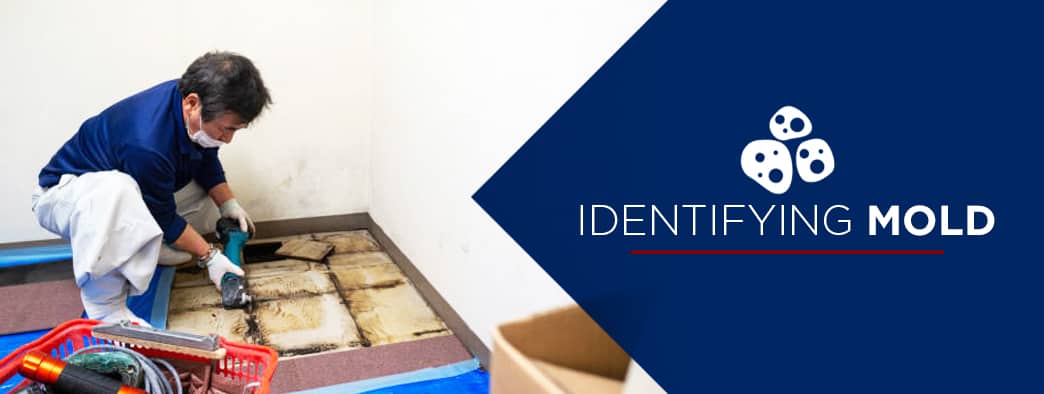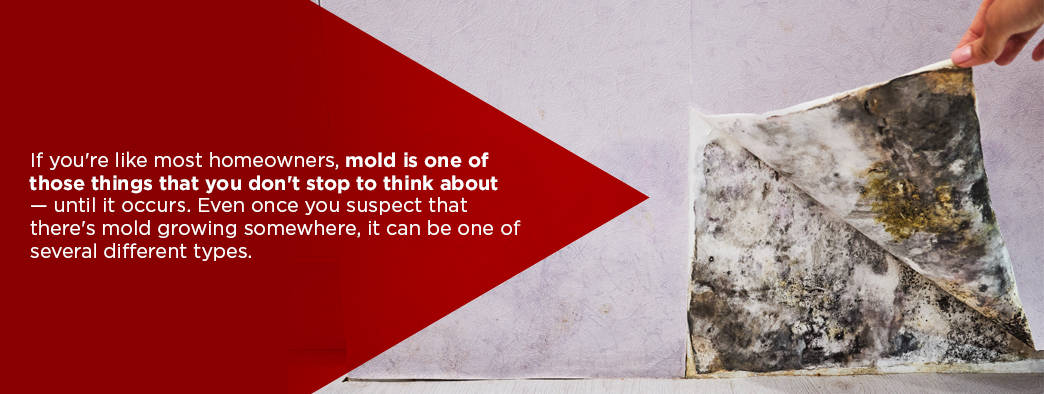How to Identify and Prevent Mold in Your Home
Dec 31, 2019

Mold is the name for a group of small organisms that thrive in damp, dark environments. When found in nature, mold aids in the breakdown of dead plants and trees. But when mold begins to grow inside, it can quickly become a problem.
When mold starts to grow inside of a home, it releases “spores” into the air. When a person breathes these spores into their lungs, it can cause a variety of health problems, especially for those who already have asthma or other upper respiratory problems.
Mold typically grows in damp areas, such as a shower or bathtub. However, it can take hold on any home surface that’s been exposed to moisture, such as the walls, ceilings, carpets or furniture.
Whether you’re a first-time homeowner or you’ve been in a home for years, mold may not be something you’ve encountered before. However, when it comes to mold identification and what to do about it, it’s important to have all the information.
How to Identify Mold in Your Home

Mold is a fungus, and there are literally millions of species of fungi on planet Earth. It would be impossible to explain each one here, but when it comes to mold, there are a few basic types to be aware of. Some are harmless and only require a quick cleanup. Others can cause serious problems if they aren’t treated and removed by a professional.
Although there are things you can do to prevent mold from growing in your home — more about that later — sometimes, it can begin to accumulate without your knowledge. And, once it does start to grow, it doesn’t always show itself right away. If you suspect that there might be mold beginning to grow in a certain area of your home, it’s important not to panic. Instead, take a few minutes to explore the area in question to determine, 1. Is it mold? and 2. What kind of mold is it?
Learn More About indoor air quality
Top 10 Things You Didn’t Know About Mold

If you’re like most homeowners, mold is one of those things that you don’t stop to think about — until it occurs. Even once you suspect that there’s mold growing somewhere, it can be one of several different types.
1. Mold Is Everywhere
All you need for mold to form is the right temperature, moisture and a food source. Although mold can stem from leaks or flooding, it can also develop in houses that don’t have any issues.
2. Mold Is Typically Classified as Either Allergenic or Toxic
Questions about mold and health are increasingly important. A lot of molds are described using words like “toxic,” and that can be scary, especially if you’re not sure if you have mold to begin with. So here’s the deal. “Allergenic” mold is a classification of mold that refers to molds that can trigger allergy-like symptoms, especially upper respiratory symptoms such as difficulty breathing and sneezing. According to the CDC, “toxic molds” are misnamed because there is limited evidence that they can cause serious health problems. However, the name persists, so it’s important to understand it before you see it in other sources.
3. Molds Come in Many Different Colors
Depending on the type of mold growing in your home, it can be brown, green, black, gray, orange or even pink! Mold colors vary depending on how old it is and what material it feeds on. Some mold species can turn two to three different colors throughout their lifespan.
4. Mold Doesn’t Just Hang Out in the Bathroom
Contrary to popular belief, mold doesn’t limit itself to your bathroom or kitchen. Mold can form anywhere there’s moisture. Mold especially loves damp, dark places, such as your basement. Mold can also grow on cabinets, windows, fabric, carpet and upholstery, especially in buildings that have recently flooded.
5. Mold Grows Fast
Mold growth can spread rapidly across surfaces in your home, especially if it’s feeding on moisture that’s left undetected, such as an undetected leaky sink. Mold also spreads through the air. How? When there’s mold located in your HVAC system, its spores can be blown through the air in your home. They eventually land on other surfaces and begin to grow there too.
6. Mold Doesn’t Have to Be Scary
Mold is more common than many people realize. It does have health implications, especially if you have other health issues or mold is present in your home in large amounts, but there’s no reason to panic if you spot a patch of mold growing somewhere in your home. There are a lot of reasons mold can form, and it can be dealt with quickly and safely.
7. “Black Mold” Isn’t as Common as You’d Think
What does black mold look like? We get this question a lot and with good reason. True “Black Mold,” also known as Stachybotrys, can cause serious health issues. There’s been a lot about it in the news lately, and people are worried, especially because children and adults with pre-existing health conditions are particularly susceptible. But there’s a difference between Stachybotrys and other house molds that can appear black in color. In fact, most of the time, if you find black-colored mold in your home, it’s not going to be Stachybotrys.
Wondering how to identify black mold? It typically forms over time in homes that have water damage or excessive humidity, perhaps from faulty HVAC systems. Homes located in humid climates or that see frequent humidifier use are also at higher risk.
8. Mold Affects People Differently
Different types of mold can cause different types of health issues. Some cause skin problems, some can cause breathing problems, and others impact major organs. But those most affected by mold tend to be children and adults with other pre-existing health conditions, such as asthma.
Some people incorrectly assume that you need to identify the species to figure out how to stop mold. Although there are hundreds of mold species out there, it’s not necessary to test the mold or go through a mold identification process before you can remove it. Besides being expensive, mold sampling also isn’t always a reliable way to determine the risk in your home because there isn’t an industry standard when it comes to acceptable types and levels of each mold species. If you have a sensitivity to mold, and you find it in your home, it should be removed — the type of mold is irrelevant to the removal process.
9. Mold Is Often a Sign That You Have a Bigger Problem
If you spot mold in your home, it’s often a sign that you have a water leak or plumbing issue that needs attention. Some species of mold also give off a musty odor, which is a telltale sign that you’ve got a bigger problem to address.
Mold is also a big concern in areas that have been impacted by significant storms and flooding. For example, mold formed in many buildings in New Orleans after Hurricane Katrina.
10. Mold Loves Warm Temperatures
Most species of mold thrive in places that are dark and warm, which could lead people to believe that mold doesn’t grow in the summer or in air-conditioned areas. But that’s not true. There are several types of mold that don’t need warm temperatures to thrive.
How to Spot Mold Growing in Your Home

What does black mold look like? Is that brown spot mold or just a stain? Although you don’t have to identify the exact species of mold to know there’s a problem, it’s a good idea to know how to spot mold growing in your home. The quicker you identify a potential problem area, the smaller the problem will be, and the easier it will be to resolve.
1. I Spy
The first thing you should do if you’re on the hunt for mold is to look around. Do you see water accumulating under the sink in the bathroom, or does it seem unusually humid in the basement? Is there a lot of condensation around your HVAC unit? In some cases, if the mold has grown rapidly or been allowed to grow for a while, you may easily spot large patches of furry or slimy mold. However, you can often identify mold before it gets to that point. Check your home for stains or discoloration on ceilings, walls, windowsills and floors. Also, pay careful attention to wallpaper, carpets and furniture, especially if they’re near a window or are older and may have been exposed to a lot of humidity or moisture over time.
2. Follow Your Nose
Certain types of mold can give off a musty or damp smell, especially if it’s down in the basement or in an area with poor ventilation. This can also occur in the bathroom or kitchen — any area where pipes can leak and cause water damage. If you smell anything unusual, follow the smell. Does it grow stronger under the kitchen sink? Does it get weaker as you walk out of the basement? These could be clues that help you hone in on the source of the moisture and the mold. Don’t forget to check carpeting or furniture as well, especially if either is older or in an area that’s exposed to higher levels of moisture.
3. Don’t Neglect the Crawlspace
If your house is built on a crawlspace, leaks or moisture can build up without you knowing about it. It’s important to inspect your crawlspace regularly to detect any leaks coming from the house above or moisture buildup that might be occurring underneath due to excessive rain or humidity in your area. A professional inspector can keep track of moisture levels over time and even install a pump to reduce moisture levels in your crawlspace if there is a concern.
4. Your Family
Has someone in your household been experiencing unusual upper respiratory symptoms? Is their doctor confused and unable to offer a diagnosis or treatment that’s cured their symptoms? Often allergic reactions to mold can be difficult to identify because they mimic allergic reactions to a lot of other things. If you notice your family having reoccurring health problems with no apparent explanation, then maybe it’s time to take a closer look at what’s going on inside of your home.
5. Context Clues
In some cases, you may want to check for mold long before you see or smell anything. If you’ve recently experienced a long stretch of heat and humidity, flooding in or around your home or a leak in your roof or pipes, take some time to inspect your home for early signs that mold is growing. The quicker you identify the problem, the easier it will be to solve it. Even if you simply wipe some mold out of your shower or the grout in your tiles, it can be a good reminder to take a few extra minutes to inspect other potential problem areas around your home.
6. Call a Professional
Even if you can’t see it — or smell it — if you suspect mold is growing in your home, it’s a good idea to call a professional mold remediation company to determine how to treat mold. They can identify potential problem areas, pinpoint the type of mold that’s growing and offer solutions for permanently and safely removing the mold from your home. Especially if you aren’t sure what kind of mold you’re dealing with, it’s better not to risk the health and safety of your family by taking matters into your own hands.
Mold and Your Health
If mold is everywhere, then why does it become such a problem when you find it in your home? In most cases, healthy adults don’t have reactions to mold growing in their home. However, there are a few types of mold — including black mold — that cause health problems even in otherwise healthy individuals. And, for adults who already have asthma or other upper respiratory issues, any kind of mold can irritate their system and cause symptoms such as coughing, sneezing, wheezing, runny nose and asthma attacks. Skin irritation is also a common symptom of mold exposure.
Individuals with compromised immune systems may also be at a higher risk for health problems as a result of mold exposure. Because their systems are already compromised, they cannot fight against the mold spores they breathe in. This can result in a variety of problems, including lung infections and the development of more serious conditions.
Another concern when it comes to mold and health issues is the exposure of children to mold. Although there is still a lot of research to be done on the subject, studies have indicated that children who are exposed to mold at an earlier age may be more likely to develop asthma.
indoor air quality Services in Central PA
How to Prevent Mold From Growing in the First Place

It’s important to identify and treat mold when it’s discovered in your home, but the best way to protect your home and your family is to prevent mold growth in the first place. So how do you do that?
1. Fix Existing Problems
If you know there’s a leak in your roof or a pipe that’s dripping, don’t wait to address it. Fix the problem and clean up any moisture that’s already entered your home. If you aren’t sure about the extent of the problem, hire a professional to evaluate it.
2. Indoor Air Quality
Using your home’s ventilation system is a great way to keep excess moisture from pooling in places it shouldn’t. This is especially important in the bathroom. Those ceiling fans aren’t just for smells, you know! Your HVAC system is also important. When the air conditioner is running, it’s also removing excess moisture from the air. If your HVAC system is old or you suspect it isn’t working properly, it’s time to consider a tune-up or a replacement. Yes, replacing your HVAC system is an expensive prospect, but the expenses you’ll incur if you allow mold to grow will far exceed the cost of a new unit.
3. Use a Dehumidifier
Ideally, the humidity in your home should stay below 50 percent. Dehumidifiers are designed to pull excess moisture from the air, making it harder for mold to grow and expand its reach. Although you can buy portable units, these units are only effective in the rooms where they’re placed. Therefore, they don’t always address the big picture when it comes to the air quality inside your home. Installing a whole-home dehumidifier is the best way to draw excess moisture out of the air and prevent mold from growing inside.
3. Refrain From Installing Carpet in Areas Prone to Moisture
There’s a reason most kitchens and bathrooms have tile or vinyl floors. Carpet attracts moisture. When it’s put in areas prone to a lot of moisture, it’s more likely to soak up the moisture and grow mold. If you live in an older home and it came with carpet in these areas, consider having it removed in favor of tile or vinyl flooring — both of which are non-porous and won’t soak up moisture.
4. Don’t Leave Wet Stuff Laying Around
Anyone who has young children knows how much water ends up on the floor during bathtime. It’s safe to assume that the bathmat is soaked, and you may have a couple of wet towels leftover too. Don’t leave these lying around! As soon as you’re done using them, get them off the floor and hang them on a towel rack or over the shower rod to dry.
If you have older children, regularly check their rooms for wet towels and clothing. Even something as simple as a sweaty soccer jersey can grow mold if it’s left to its own devices. Although it may not seem like it’s worth the argument that ensues every time you ask your teenager to pick up their room, we promise it’s worth it in the long run.
5. Keep Things Clean
We’re not suggesting that you should deep clean your home every week, but a simple and frequent cleaning routine can go a long way toward keeping mold at bay. Wipe down surfaces and floors in the kitchen and bathroom throughout the day or as needed when you spill food or drinks. Don’t leave liquids sitting out, even if they’re on non-porous surfaces. Regularly wipe down surfaces in the bathroom as well, especially in the shower where water tends to collect in corners and crevices.
6. Air Quality Testing
If you aren’t sure of what your home needs or the best way to prevent mold, then you might want to consider air quality testing. These tests evaluate the air quality in your home and help determine the best way to prevent mold and other allergens from becoming a problem. When you hire a professional company to provide air quality testing, they can advise you on the best steps to take for your specific home and needs. They are also familiar with the weather in the area where you reside and will factor that into their recommendation.
Think Home Climates for Indoor Air Quality Control
The best way to deal with mold is to prevent it from taking hold in your home. Evaluating the air quality in your home and taking control before things spiral out of control is the best way to protect your home and your loved ones who live there.
To manage your HVAC and air quality needs, Home Climates provides a variety of services in and around Harrisburg, including humidifier/dehumidifier and air purifier installation, plumbing and HVAC repair and a variety of HVAC systems for purchase. Our commitment to excellence have earned us a trusted reputation throughout the region. Whether you’re addressing a mold problem or looking to get ahead of the game, we’re ready to help. For air quality testing or a free quote, call us today at 717-689-4151 or visit us online.

